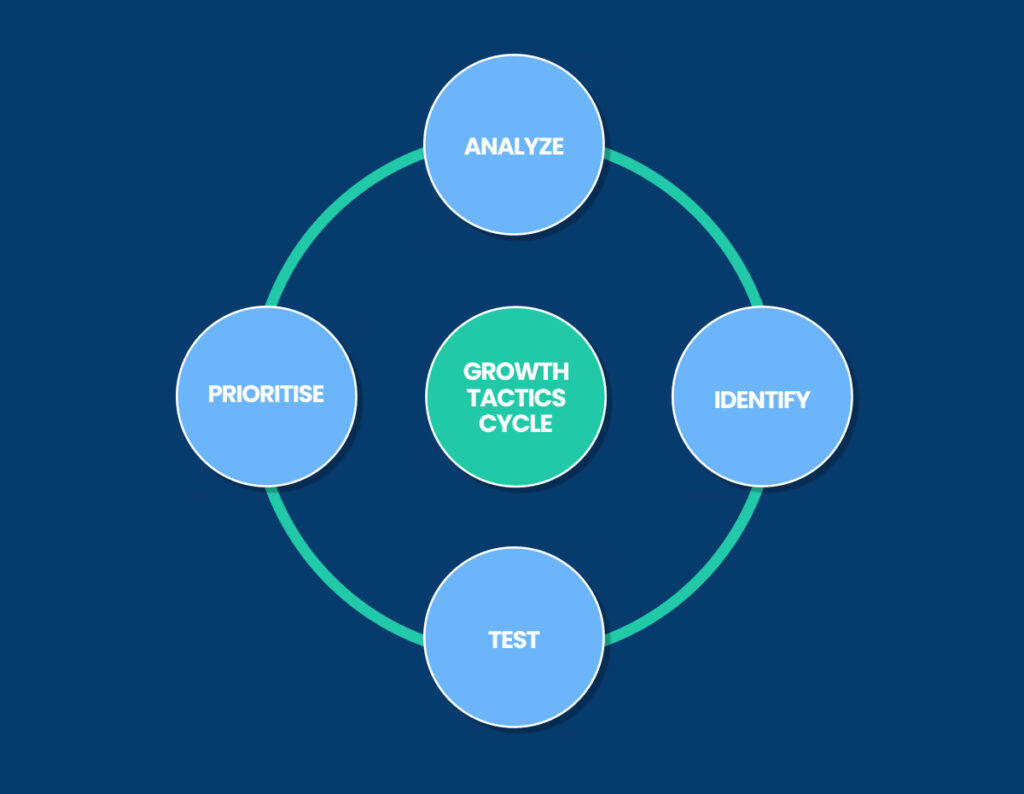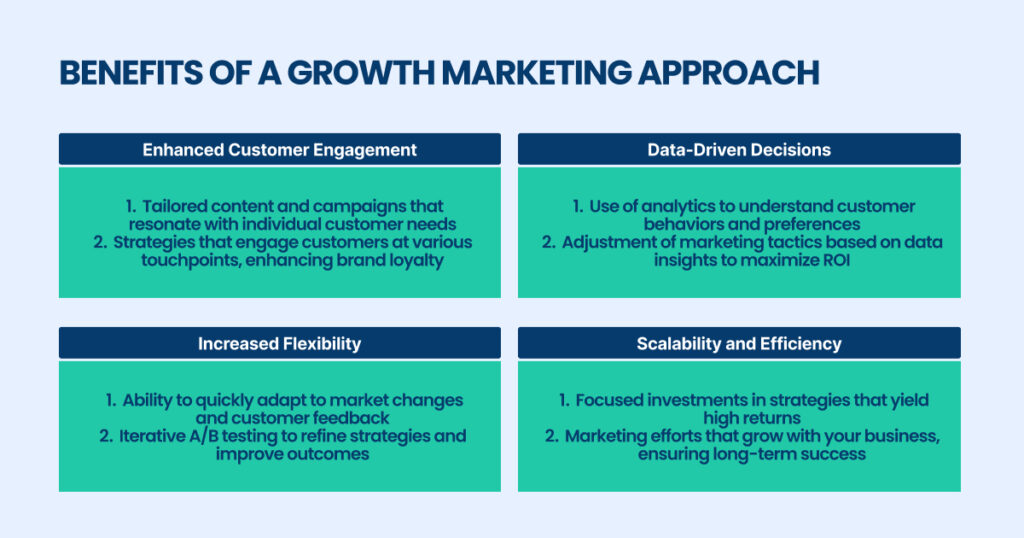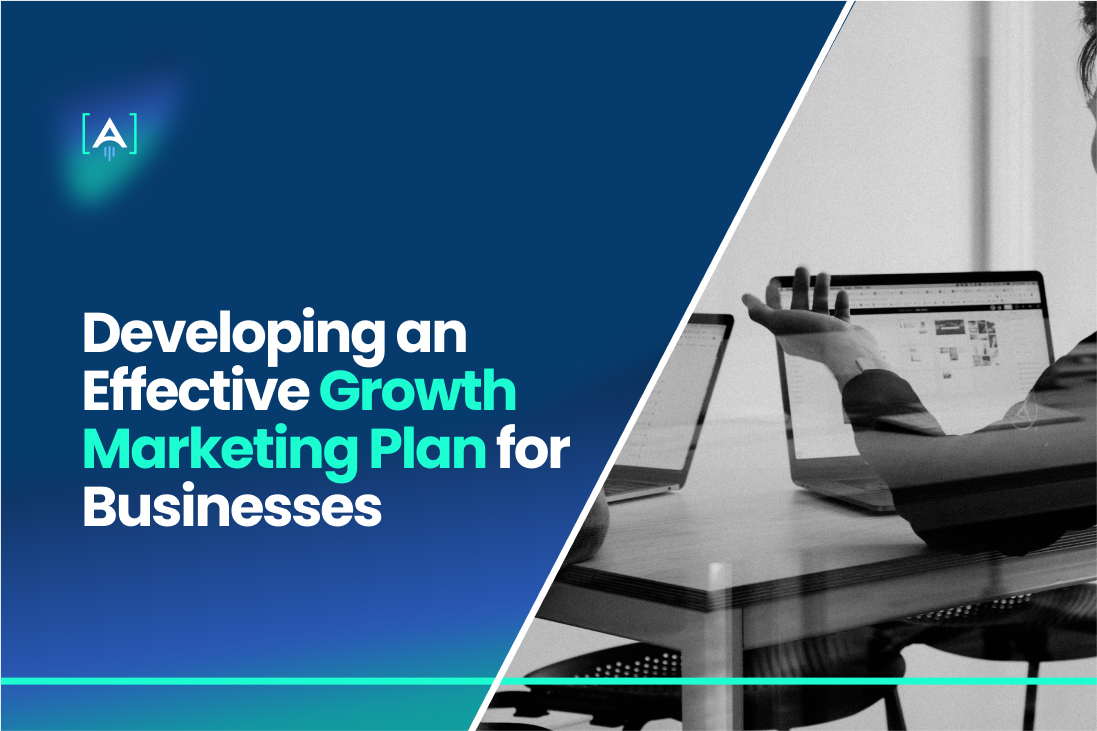Growth marketing requires everyday dedication.
It is not a secret that consistent effort helps businesses keep relevance and competitiveness in their market.
During the process, companies apply various methods. In that routine, cooperation with a growth marketing agency can leverage specialized expertise to implement tailored growth marketing strategies.
These strategies focus on measurable growth, utilizing data-driven techniques and innovative approaches to maximize ROI and accelerate business success.
In this blog post, you will find out how important the Growth Marketing Plan and development strategies are.
We’ll even provide a helpful marketing plan example to get you started.
What Is Growth Marketing?
Growth marketing is a dynamic and holistic approach that focuses on building and optimizing every stage of customer growth to drive sustainable growth over time.
Unlike traditional marketing, which often prioritizes broad-based campaigns and short-term results, growth marketing emphasizes measurable impact, scalability, and customer engagement at all levels.
Source: Ahrefs
This approach integrates various innovative tactics and strategies, making it indispensable for businesses, especially startups, aiming to scale rapidly and efficiently.
Understanding Growth Marketing
At its core, growth marketing extends beyond acquiring new customers to encompass activation, retention, and upselling, ensuring that each customer’s value is maximized over time.
Growth marketing strategies can be adapted for different business models and industries.
B2B Growth Marketing, for example, focuses on acquiring and retaining businesses as customers. Strategies often involve thought leadership content, targeted social media campaigns, and free trials with clear value propositions.
SaaS Growth Marketing prioritizes user activation, engagement, and upselling of existing customers. Freemium models, in-app tutorials, and personalized onboarding experiences are common examples.
A typical growth marketing plan example includes detailed, data-driven strategies that benefit to specific customer needs and market demands. Growth marketers use data analytics and user feedback to refine their strategies continually, ensuring adaptability and responsiveness to changing market conditions.
Benefits of a Growth Marketing Approach
One of the primary benefits of adopting growth marketing is its focus on long-term customer relationships.
Businesses can enhance customer loyalty and lifetime value by employing personalized retargeting and sophisticated retention tactics.

Additionally, growth marketing’s reliance on AI marketing tools enables the automation of complex tasks such as customer segmentation and lead scoring, improving efficiency and precision in targeting potential customers.
Growth marketing also prioritizes flexibility, allowing companies to test new ideas quickly and iterate based on results.
Techniques like A/B testing are central to this approach, helping marketers understand what works best and refine their strategies in real-time. This test-and-learn methodology significantly reduces risk and enhances the overall effectiveness of marketing campaigns.
Key Differences Between Growth Marketing and Traditional Marketing

The divergence between growth marketing and traditional marketing is stark in several ways:
- Objective Focus: Traditional marketing often aims to increase visibility and brand awareness through broad-spectrum campaigns.
Contrary to this, growth marketing focuses on the entire funnel, from awareness through acquisition to retention and referral, making it a more integrated approach.
- Data Utilization: Growth marketing heavily relies on data analytics and AI technologies to forecast trends, personalize experiences, and automate processes.
Traditional marketing may utilize data, but not to the same extent or depth as growth marketing strategies.
- Agility: Growth marketers operate on rapid testing and learning cycles, which allows for quick pivots and adaptations based on what the data shows.
Traditional marketing campaigns are typically less flexible, with longer planning cycles and execution timelines.
- Technological Integration: Growth marketing often integrates the latest technologies, including AI marketing tools, to optimize campaigns and automate decision-making processes.
This use of technology is less prevalent in traditional marketing strategies, which tend to rely more on established, less dynamic methods.
- Customer Engagement: Growth marketing examples are designed to engage with the customer at multiple points in their journey, creating a more personalized and engaging experience.
Traditional marketing methods might not always account for this sustained engagement, often focusing on initial acquisition without strongly emphasizing retention and loyalty.
Strategies Employed in Growth Marketing
- Demand generation: This involves creating awareness and demand for a product or service with the help of targeted marketing campaigns, often leveraging content marketing and SEO strategies.
- Retention strategy: Growth marketers develop programs to increase customer loyalty and prevent churn. This might include loyalty programs, user onboarding sequences, regular feedback loops, and personalized communications.
- Retargeting: Retargeting is used to re-engage customers who have shown interest but did not complete a conversion. By showing relevant ads based on their previous interactions, companies can increase the chances of converting these leads into paying customers.
- Startup growth: Growth marketing strategies focus on rapid experimentation and scalability, helping these businesses grow their user base and revenue without investing heavily in traditional advertising.
Defining Your Business Goals
Defining your business goals is a critical first step in any marketing plan example, as it sets the direction and focus for all subsequent marketing efforts.
Source: Ahrefs
In growth marketing, where strategies are designed to rapidly test, measure, and optimize, having clear, well-defined goals is essential to guide decision-making and evaluate the effectiveness of initiatives.
Short- and long-term goals play crucial roles, each serving distinct purposes within an overarching growth strategy.
Short-term vs Long-term Goals
Short-term goals in growth marketing are typically aimed at immediate gains and quick wins. These might include increasing monthly website traffic, improving email campaign open rates, or boosting conversion rates over the next quarter.
The primary advantage of short-term goals is that they provide immediate feedback and results, allowing marketers to assess what’s working and what’s not quickly.
This agility is vital in growth marketing, where the ability to start and adapt strategies based on real-time data is a key determinant of success.
Conversely, long-term goals focus on sustainable growth and the company’s broader vision. These goals are often strategic and impact the business higher, such as achieving a certain market share, entering new markets, or developing and launching new product lines within a year or more.
Long-term goals require persistent efforts and are critical for guiding growth strategies and ensuring alignment with the company’s overall objectives.
SMART Goal Framework
To effectively set both goals, growth marketers rely on the SMART goal framework, which ensures that aims are Specific, Measurable, Achievable, Relevant, and Time-bound.
Source: Sandiego
This growth marketing framework helps refine the planning process and align it with the company’s growth marketing strategies.
- Specific: Goals should be clear and targeted to avoid doubt. For instance, instead of aiming to “increase traffic,” a more specific goal would be to “increase traffic by 30% through SEO and content marketing strategies.”
- Measurable: Each goal should have criteria for measuring progress and success, such as KPIs (Key Performance Indicators). This could include parameters like customer acquisition cost, lifetime value, or conversion rates, which are essential for tracking the ROI of marketing efforts.
- Achievable: While goals should be challenging, they must also be realistically attainable within the available resources and market conditions. This is where growth marketing agencies often come into play, offering expertise to assess what can be achieved realistically and by what means.
- Relevant: Goals must align with the broader business objectives and market strategy. This ensures that every effort contributes positively to the organization’s overarching aims, maximizing the impact of growth marketing strategies.
- Time-bound: Assigning deadlines and timeframes helps prioritize tasks and maintain momentum. This is particularly important in a dynamic environment where the window for capitalizing on trends or technologies can be short.
Integrating Advanced Methodologies
Incorporating methodologies like the hook model, ICE scoring, and experimentation roadmaps can significantly enhance the goal-setting process.
The Hook Model, for example, focuses on creating user habits that stick, which is vital for customer retention strategies. ICE Scoring (Impact, Confidence, Ease) helps prioritize ideas and experiments based on their potential impact, confidence in their success, and ease of implementation.
This prioritization is crucial when managing limited resources and must align with short-term and long-term goals.
Balancing Paid vs Organic Strategies
A balanced approach to paid and organic strategies is also crucial in achieving both goals. While paid strategies can drive quick results and are valuable for meeting short-term goals, organic strategies are more sustainable and crucial for long-term success.
Prioritizing one over the other should be based on the marketer KPIs and the AI ROI from previous campaigns, guiding investment in the most effective channels.
Implementing the Plan
Implementing a marketing plan example requires meticulous attention to budget allocation, execution timelines, and team and resource management.
Source: Implementationpractice
Each of these elements plays a crucial role in translating strategic goals into actionable results, ensuring that every marketing effort effectively contributes to overall business growth.
Budget Allocation
The financial backbone of any growth marketing strategy involves a carefully planned budget allocation. This financial planning must be strategic and flexible, accommodating expected and unexpected changes in the marketing landscape.
Within budget allocation, there are two critical considerations: cost-effective strategies and ROI considerations.
Source: itsm
Cost-effective strategies are essential, especially for startups and smaller companies with tight budgets. Growth marketers must explore innovative marketing strategies that offer high returns on minimal investments.
This might involve leveraging underutilized marketing channels, focusing on retaining existing customers through personalized engagements or adopting viral marketing tactics that require little investment but can yield high visibility.
ROI considerations are integral to justifying every dollar spent. Marketers should establish clear KPIs (Key Performance Indicators) to assess the effectiveness of each marketing activity. These indicators help identify which strategies are working and which are not, ensuring that the budget can be reallocated swiftly to maximize impact.
Techniques like A/B testing integrated within an experimentation roadmap can provide real-time data, helping refine strategies to target the audience better and improve the overall effectiveness of the marketing spend.
Execution Timeline
Implementing a marketing plan example also demands a well-defined execution timeline. This timeline is structured around implementation phases and is often guided by agile marketing approaches.
Implementation phases should be clearly defined from the outset. This involves the setup or onboarding phase, where goals are set, teams are formed, and initial strategies are mapped out.
Source: itsm
Following this, the focus shifts to executing planned strategies—this phase is dynamic and might involve iterative cycles of testing and modification to refine approaches based on real-time feedback and data. Finally, there is the scaling phase, where successful strategies are expanded and optimized to drive broader business growth.
Agile marketing approaches are critical in today’s fast-paced marketing environment. These approaches allow teams to remain flexible, adapting quickly to market changes or new insights.
Agile methodologies encourage short sprints of work, frequent reassessments, and continuous improvement, making them ideal for growth marketing strategies where conditions can evolve rapidly.
Team and Resources
No marketing plan example can be executed without a capable team and the necessary resources. Building the right marketing team and deciding between outsourcing and in-house management are pivotal decisions that can profoundly affect on the effectiveness and efficiency of marketing operations.
Building a marketing team involves more than hiring the right people; it fosters a culture of innovation, collaboration, and data-driven decision-making.
The team should have diverse skills and expertise, from data analysts who can decipher complex consumer data to content creators who can engage and convert audiences. Training and development are also crucial to keep the team informed on the latest marketing trends and technologies.
The decision between outsourcing and in-house management of marketing functions often depends on several factors, including budget constraints, control preferences, and the nature of the tasks. Outsourcing to growth marketing agencies can be advantageous, especially when high-level expertise or additional resources are needed temporarily.
These agencies bring specialized knowledge and experience, often accelerating the achievement of complex marketing goals. However, it’s vital to engage in a thorough marketing agency onboarding process, and questions to ask a growth agency will ensure the agency aligns with your business objectives and culture.
On the other hand, in-house management provides greater control over marketing strategies and a deeper integration with the company’s core operations. It allows for building a dedicated team that fully aligns with the company’s long-term vision and can grow with the organization.
When deciding between outsourcing and in-house, consider factors such as strategy scalability, the need for specialized skills, and the importance of brand consistency.
Scaling Strategies
Scaling a business is an exciting phase, but it demands careful planning and strategic implementation. When a company reaches a point where the initial stages of growth have been successfully navigated, the focus shifts to scaling strategies that can expand the business sustainably.
Effective scaling is not just about growing quickly; it’s about growing smartly and sustainably, ensuring the business can handle increased demand without compromising on quality or customer satisfaction.
When and How to Scale
Deciding when to scale involves carefully assessing the market, the business’s current position, and future potential. A growth marketing plan is crucial here, providing a roadmap that aligns marketing efforts with scalable opportunities.
The decision to scale should be based on solid data indicating consistent growth patterns, such as increased demand for products or services, expanding market opportunities, or significant improvements in operational efficiencies. It’s also essential to have the right systems, processes, and people in place to support growth.
Once the decision to scale has been made, the how becomes crucial. Scaling strategies must be integrated into the growth marketing strategies, ensuring that they reinforce one another.
This integration involves expanding marketing channels that have proven effective, optimizing the marketing mix, and enhancing customer touchpoints to support a larger audience without losing the personal touch that may have contributed to initial success.
Effective Growth Marketing Strategies for Scaling
- Enhancing Digital Presence: Enhancing businesses’ digital presence becomes crucial as businesses scale. This might involve a more aggressive SEO strategy, broader social media campaigns, or more sophisticated content marketing.
Each of these tactics should be designed to get a wider audience and engage them more deeply.
- Leveraging Data Analytics: Scaling successfully requires a deep understanding of customer behavior, market trends, and operational metrics.
Utilizing data analytics in your growth marketing strategies can provide insights that drive smarter business decisions, from product development to customer service enhancements.
- Optimizing Customer Acquisition: As the business grows, optimizing the cost of customer acquisition becomes more crucial. This can involve refining targeting strategies, improving conversion rates through testing and optimization, and exploring new, cost-effective marketing channels.
- Expanding Geographic Reach: One common scaling strategy is geographic expansion.
This requires marketing to a broader audience, understanding regional differences, and tailoring marketing messages accordingly.
- Diversifying Offerings: Adding new products or services or enhancing existing ones can provide new revenue streams and help absorb increased demand.
This diversification should be based on customer feedback and market research to ensure it meets actual customer needs.
Managing Growth Sustainably
Sustainable growth is about managing resources wisely, maintaining quality, and ensuring that the business remains agile. This involves several key strategies:
- Maintaining Quality Control: As operations scale, keeping the quality of products or services can become problematic.
Implementing rigorous quality control processes and scaling up resources proportionately to demand is vital.
- Building a Scalable Infrastructure: Whether IT systems, logistic capabilities, or customer service, infrastructure must scale along with the business.
This might mean investing in technology that automates certain processes or expanding facilities to handle increased production needs.
- Fostering a Strong Company Culture: As businesses grow, preserving a strong and cohesive company culture becomes challenging but crucial for long-term success.
This includes maintaining open lines of communication, nurturing leadership at all levels, and guaranteeing that all employees are aligned with the company’s core values and objectives.
- Ensuring Financial Health: Effective financial management becomes even more critical as a business scales.
This includes managing cash flow carefully, securing adequate funding for expansion, and maintaining a clear focus on profitability, not just growth.
- Environmental and Social Responsibility: Sustainable scaling also means considering growth’s environmental and social impact.
This involves adopting practices that are economically sustainable, socially responsible, and environmentally friendly.
Partner with [A] Growth Agency for Your Growth Marketing Plan
This marketing plan example can significantly enhance your business’s capabilities.
The correct partnership will navigate complex market dynamics and drive sustainable growth. [A] Growth Agency can be your lead in the process.
Our growth marketers are well-versed in the latest trends and technologies, enabling you to design innovative marketing strategies that capture and convert your target audience.
We employ sophisticated data analytics platforms to advanced AI-driven marketing tools to improve your targeting precision and campaign performance.
If this attracts you and you already have ideas to discuss, don’t wait!

